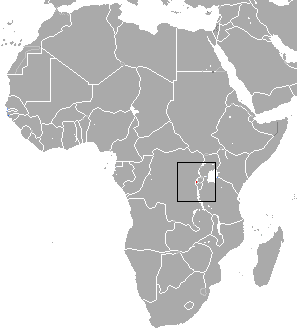Rhinolophus hilli facts for kids
Quick facts for kids Rhinolophus hilli |
|
|---|---|
| Conservation status | |
| Scientific classification | |
| Genus: |
Rhinolophus
|
| Species: |
hilli
|
 |
|
| Hill's horseshoe bat range | |
Rhinolophus hilli, also known as Hill's horseshoe bat, is a very special type of bat. It belongs to the Rhinolophidae family, which are often called horseshoe bats because of their unique nose shape. This bat is found only in Rwanda, a country in Africa.
Hill's horseshoe bat lives in places like moist montane forests (forests on mountains), caves, and other underground spots. It is a very rare animal. In 2013, a group called Bat Conservation International put this bat on a list of 35 top priority species to protect worldwide. It is in danger mainly because its habitat (the place where it lives) is being lost.
About Hill's Horseshoe Bat
Its Bat Family
The group of bats called Rhinolophus has many different species. Scientists divide them into smaller groups to study them better. Hill's horseshoe bat is part of a group called the maclaudi group. This group currently has six known species. Many of these were only discovered recently, after 2003!
Bats in the maclaudi group have large ears. They also have a special nose shape that looks a bit like a horseshoe. This shape helps them use echolocation to find their way around and hunt insects.
Here are some of the bats in this special group:
- Maclaud's horseshoe bat (R. maclaudi)
- Rhinolophus willardi (found in 2013)
- Ruwenzori horseshoe bat (R. ruwenzorii)
- Hill's horseshoe bat (R. hilli)
- Rhinolophus kahuzi (found in 2013)
- Ziama horseshoe bat (R. ziama)
Two of these bats, R. maclaudi and R. ziama, live in West Africa. The other four, including Hill's horseshoe bat, live further east around a place called the Albertine Rift. The West African bats are usually bigger than the East African ones. R. maclaudi is the largest bat in this whole group.
Because these bats look very similar, scientists once thought that Hill's horseshoe bat and the Ruwenzori horseshoe bat were the same kind of bat. They even thought they might be a type of Maclaud's horseshoe bat. But now we know they are different species!
Protecting This Rare Bat
Scientists first found Hill's horseshoe bat in 1964 and then again in 1981. These two bats were found only about 8 kilometers (5 miles) apart. We still don't know where these bats sleep during the day.
The International Union for Conservation of Nature (IUCN) says this bat is critically endangered. This means it is at a very high risk of disappearing forever. There are a few reasons for this:
- It lives in a very small area, less than 100 square kilometers (39 square miles).
- Its habitat is being destroyed.
- There are only a few small groups of these bats left.
- Sometimes, bats are hunted for food.
There is some good news! In 2019, Hill's horseshoe bat was seen again for the first time since 1981. A single bat was found in Nyungwe National Park in Rwanda. Scientists recorded its calls. Since then, they have used these calls to find the bat in eight other places in the area. This gives hope for protecting this rare and special bat!


